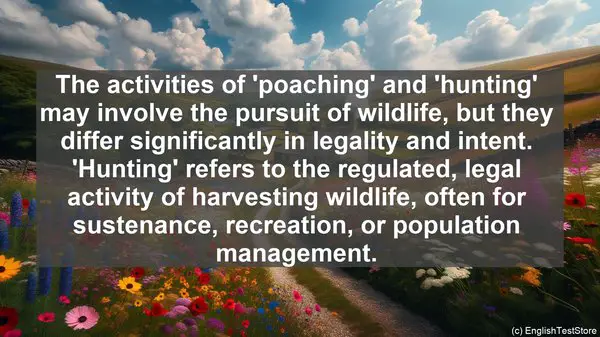Introduction
Today, we’re diving into the fascinating world of wildlife management. While this field offers endless opportunities, it also presents some linguistic challenges. In this lesson, we’ll explore the top 10 commonly confused words in wildlife management, ensuring you’re equipped with the right vocabulary for your future endeavors.
1. Habitat vs. Ecosystem
Often used interchangeably, ‘habitat’ and ‘ecosystem’ have distinct meanings. A ‘habitat’ refers to the specific environment where a particular species lives, encompassing its food, water, and shelter requirements. On the other hand, an ‘ecosystem’ is a broader concept, including all living organisms and their interactions with the environment. While a habitat can exist within an ecosystem, the two terms shouldn’t be used interchangeably.
2. Endangered vs. Threatened
When discussing species at risk, ‘endangered’ and ‘threatened’ are often confused. ‘Endangered’ refers to a species that is at a high risk of extinction, with its population critically low. In contrast, a ‘threatened’ species is one that is likely to become endangered in the near future if conservation measures aren’t taken. Understanding this distinction is crucial for prioritizing conservation efforts.
3. Migration vs. Hibernation
While both migration and hibernation are strategies animals use to cope with changing environmental conditions, they differ significantly. ‘Migration’ involves the seasonal movement of animals from one region to another, often in search of better resources. On the other hand, ‘hibernation’ is a state of inactivity animals enter during the winter months, characterized by reduced metabolic rates and lowered body temperatures. These adaptations help animals conserve energy when resources are scarce.
4. Prey vs. Predator
In the intricate web of wildlife interactions, ‘prey’ and ‘predator’ are two crucial roles. ‘Prey’ refers to the animal that is hunted and consumed by another species, known as the ‘predator.’ This relationship is essential for maintaining the balance of ecosystems, as it regulates population sizes and prevents the dominance of a single species.

5. Biodiversity vs. Species Richness
Often used synonymously, ‘biodiversity’ and ‘species richness’ have subtle differences. ‘Biodiversity’ encompasses not only the number of species in an area but also their genetic variation and the variety of ecosystems they inhabit. ‘Species richness,’ on the other hand, focuses solely on the number of different species present. Both concepts are vital for understanding the complexity and resilience of ecosystems.
6. Exotic vs. Invasive
When discussing non-native species, it’s essential to differentiate between ‘exotic’ and ‘invasive.’ An ‘exotic’ species is one that is introduced to an area outside its natural range, often intentionally. While not all exotic species cause harm, some can become ‘invasive.’ An ‘invasive’ species is characterized by its ability to rapidly spread and outcompete native species, often causing ecological and economic damage.
7. Conservation vs. Preservation
While both terms relate to protecting the environment, ‘conservation’ and ‘preservation’ have distinct approaches. ‘Conservation’ focuses on the sustainable use and management of natural resources, ensuring their availability for future generations. ‘Preservation,’ on the other hand, emphasizes maintaining ecosystems in their pristine state, often with minimal human intervention. Both approaches are essential for safeguarding our natural heritage.
8. Indicator Species vs. Keystone Species
In ecological assessments, ‘indicator species’ and ‘keystone species’ serve different purposes. An ‘indicator species’ is one whose presence, absence, or abundance can provide insights into the overall health of an ecosystem. On the other hand, a ‘keystone species’ is one that has a disproportionately large impact on its environment, often influencing the presence and abundance of other species. Both types of species are crucial for ecological monitoring and management.
9. Carrying Capacity vs. Overpopulation
Understanding population dynamics is essential in wildlife management. ‘Carrying capacity’ refers to the maximum number of individuals an environment can sustainably support, considering available resources. ‘Overpopulation,’ on the other hand, occurs when a population exceeds the carrying capacity, leading to resource depletion and other ecological imbalances. Striking a balance between population size and available resources is crucial for maintaining healthy ecosystems.

10. Poaching vs. Hunting
The activities of ‘poaching’ and ‘hunting’ may involve the pursuit of wildlife, but they differ significantly in legality and intent. ‘Hunting’ refers to the regulated, legal activity of harvesting wildlife, often for sustenance, recreation, or population management. ‘Poaching,’ on the other hand, involves the illegal hunting or capturing of wildlife, often driven by commercial interests. Poaching poses a significant threat to many endangered species and is a focus of conservation efforts worldwide.
